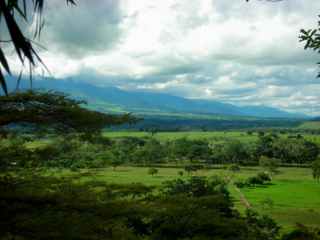
Barinas State is one of the 23 states of Venezuela. The state capital is Barinas.

The State of Mérida commonly known simply as Mérida is one of the 23 states of Venezuela. The state capital is Mérida, in the Libertador Municipality.

The Llanos is a vast tropical grassland plain situated to the east of the Andes in Colombia and Venezuela, in northwestern South America. It is an ecoregion of the tropical and subtropical grasslands, savannas, and shrublands biome.

The Apure River is a river of southwestern Venezuela, formed by the confluence of the Sarare and Uribante near Guasdualito, in Venezuela, at 7°15′N70°40′W, and flowing across the Llanos into the Orinoco. It provides significant transportation in the area.
The University of the Andes is the second-oldest university in Venezuela, whose main campus is located in the city of Mérida, Venezuela. ULA is the largest public university in the Venezuelan Andes, having one of the largest student bodies in the country.
The Quasar Equatorial Survey Team (QUEST) is a joint venture between Yale University, Indiana University, and Centro de Investigaciones de Astronomia (CIDA) to photographically survey the sky using a digital camera, an array of 112 charge-coupled devices. Since 2009, it has used the 1 m ESO Schmidt Telescope in Chile. From 2003–2007, it used the 48 inch (1.22 m) Samuel Oschin telescope at the Palomar Observatory. Before that, it had used the 1.0-metre Schmidt telescope at the Llano del Hato National Astronomical Observatory in Venezuela.
The Centro de Investigaciones de Astronomía (CIDA) is an institution in Venezuela, founded in honour of Francisco J. Duarte in 1975 for promoting observation, investigation, experimentation, theoretical work, and dissemination of research in the field of astronomy. It runs the Llano del Hato National Astronomical Observatory and is one of the collaborators in QUEST.

The Llano del Hato National Astronomical Observatory is an astronomical observatory in Venezuela. It is 3600 meters above sea level and is the country's main observatory. It is situated above the village of Llano del Hato in the Venezuelan Andes, not far from Apartaderos which lies about 50 kilometers north-east of Mérida, Mérida State.

The Virgo Stellar Stream, also known as Virgo Overdensity, is the proposed name for a stellar stream in the constellation of Virgo which was discovered in 2005. The stream is thought to be the remains of a dwarf spheroidal galaxy that is in the process of merging with the Milky Way. It is the largest galaxy visible from the Earth, in terms of the area of the night sky covered.

José Antonio de Armas Chitty was a Venezuelan historian, poet, chronicler, essayist, biographer and researcher.

Mérida, officially known as Santiago de los Caballeros de Mérida, is the capital of the municipality of Libertador and the state of Mérida, and is one of the main cities of the Venezuelan Andes. It was founded in 1558 by Captain Juan Rodríguez Suárez, forming part of Nueva Granada, but later became part of the Captaincy General of Venezuela and played an active role in the War of Independence.

The Climate of Venezuela is characterized for being tropical and megathermal as a result of its geographical location near the Equator, but because of the topography and the dominant wind direction, several climatic types occur which can be the same as found in temperate latitudes, and even polar regions. Latitude exerts little influence on the Venezuelan While the coastal cities of Maracaibo, Barcelona, Porlamar and Maiquetia can get extremely hot, cities located at valleys such as Mérida, Caracas, Los Teques and San Cristobal have cooler climates, and the highest towns of Mucuchies and Apartaderos have cold (tundra) climates.

Timoto–Cuica people were an indigenous people of the Americas composed primarily of two large tribes, the Timote and the Cuica, that inhabited in the Andes region of Western Venezuela. They were closely related to the Muisca people of the Colombian Andes, who spoke Muysccubun, a version of Chibcha. The Timoto-Cuicas were not only composed of the Timote and the Cuica groups, but also of smaller tribes including the Mucuchíes, the Miguríes, the Tabayes and the Mucuñuques.

The Venezuelan Andes also simply known as the Andes in Venezuela, are a mountain system that form the northernmost extension of the Andes. They are fully identified, both by their geological origin as by the components of the relief, the constituent rocks and the geological structure.

Science and technology in Venezuela includes research based on exploring Venezuela's diverse ecology and the lives of its indigenous peoples.

Gender equality is established in the constitution of Venezuela and the country is a signatory of the United Nations's Convention on the Elimination of All Forms of Discrimination Against Women. However, women in the history of Venezuela have played asymmetrical roles in society compared to men. Notable women have participated in the political history since the Venezuelan War of Independence in the 19th century, but universal suffrage was not granted until 1947.

Tourism in Venezuela has been developed considerably for decades, particularly because of its geographical position, the variety of landscapes, the richness of plants and wildlife, the artistic expressions and the privileged tropical climate of the country, which affords each region throughout the year. Since 2013 the country is having a very severe economic and political crisis affecting tourism all over the country.

The Táchira Depression is a saddle of land connecting the Lake Maracaibo basin to the Orinoco basin in the state of Táchira, Venezuela. It forms a break in the eastern Andes, separating the Tamá Massif to the west from the Cordillera de Mérida to the east. The depression has been thought to present a barrier to the movement of species between the Colombian and Venezuelan Andes, but this effect may have been relatively low during the recent ice ages. The mountains of the region have potential for coffee farming and hydroelectric power generation, while the lower levels are suitable for farming.
Alejandra Melfo is a Uruguayan-born Venezuelan physicist. She is known for her efforts studying and conserving glaciers, especially the Humboldt Corona, the last glacier in Venezuela.

Iván Darío Maldonado Bello was a Venezuelan lawyer and businessman. He is known for his contributions to the Venezuelan agriculture and livestock industry, his career as a businessman in the banking and insurance sectors, and his work as a conservationist. He also served as Director of Livestock at the Ministry of Agriculture and Breeding (1940) and as Governor of the state of Carabobo (1957).
















